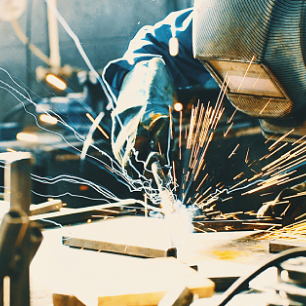Jump to:
Inside Diameter Valve Hardfacing: Using Plasma Transferred Arc Welding
One of the most challenging undertakings in the field of welding engineering endeavors is inside diameter (ID) valve hardfacing. Why? Difficulties arise due to the following factors: 1) ID hardface groove accessibility, especially as the valve’s diameter decreases, and the groove location within the valve increases; 2) the lack of direct groove visibility; 3) the need for accurate groove and torch tracking; 4) the geometry of the groove; and 5) the prerequisite for specialized tooling, inspection, and hardfacing equipment.
For example, in manufacturing naval and commercial valves, the hardfacing process is used to deposit a wear-resistant alloy onto an ID fluid sealing surface for an actuating disc. The plasma transferred arc welding (PTAW) process was used to hardface the ID elliptical groove — Fig. 1.
In a piping system, the most critical component is a valve. This article discusses the PTAW ID hardfacing of an exhaust valve body, an integral piping component of an aircraft carrier’s steam catapult system.
Manufacturing Overview
To provide a wear-resistant fluid sealing surface for an internal actuating disc, certain valves require a hardfacing alloy to be circumferentially deposited in an ID groove. The valve body in Fig. 1 is an AISI 4130 chrome-moly alloy, with a 16-in. ID and a 2.5-in. wall thickness at the groove. In terms of hardfacing, one layer of a PTAW Stellite 156 powder was deposited, consisting of three side-by-side hardfacing beads — Fig. 2.
The nominal deposit thickness was 0.13 in., of which approximately 0.060 in. was to be removed during final machining. The target deposit hardness was ≥ 46 Hardness Rockwell C. The valve body weighed 1900 lb, which is a sizeable heat-sink mass for process variable development involving amperages, travel speeds, bead toe dwell times, torch oscillation speeds, preheating, interpass, and stress-relieving temperature criteria.
Hardfacing Execution Plan
Details matter in planning, preparing, and executing hardfacing production operations. Thus, a hardfacing execution plan was developed before production. A PTAW hardfacing execution plan is a proactive approach that outlines production requirements and practices.
An execution plan details attributes that control the quality of the hardface deposit, such as the preheating method, the valve body cooling method, interpass temperature control, as well as groove travel programming, powder size, training, metrology, machining, cleaning criteria, specialized tooling and equipment, stress relieving, and nondestructive examination (NDE). The procedure qualification record (PQR) and the welding procedure specification (WPS) were qualified per Naval Sea Systems Command (NAVSEA) S9074-AQ-GIB-010/248, Requirements for Welding and Brazing Procedure and Performance Qualification.
Groove Travel Programming
Maintaining the relationship between the ID circumferential elliptical hardfacing groove and the torch during hardfacing required a few steps.
First, laser metrology was used to align the positioner table and valve body groove with the PTAW torch. To accurately program the programmable logic controller (PLC), such that the torch was positioned correctly during elliptical groove rotation, the valve body had to be concentric and perpendicular to the torch. Also, for the PLC to determine the exact location of the groove relative to the torch during rotation, an encoder was vital.
The PLC was programmed to calculate a sine wave path where the positioner table encoder sent digital signals to the PLC relative to the groove’s rotational travel speed and travel distances. The PLC, in turn, sent signals to the PTAW pendant, which signaled the torch carriage motor to move the torch inward or outward, respectively, to the groove’s axial location — Fig. 3.
The encoder, PLC, and pendant worked together throughout the hardfacing process to accurately maintain the groove position and torch relationship. With the torch mounted in the 6:00 position, the ID groove rotated clockwise during hardfacing at a travel speed of 2.2 in./min, and it took approximately 24 min to complete one 360-deg rotation.
Production Hardfacing Preparation Steps
Clear thinking is a decisive human performance attribute required to achieve quality hardfacing. Also, adhering to the execution plan means planning the work and working the plan. It is essential that, before commencing production hardfacing, everything is in order.
Thus, before the imminent hardfacing of the valve body ID, the following steps were performed:
- The ID groove was visually inspected and cleaned (i.e., wire brushed and acetone wiped).
- The PTAW equipment and the positioner were inspected.
- The valve body was then attached to the positioner table.
- The WPS process variables were entered into the PTAW pendant’s computer program.
- The torch nozzle’s plasma gas and powder orifices were cleaned, and a new tungsten electrode was installed (i.e., 0.19-in. diameter, EWTh-2).
- Stellite 156 hardfacing powder was loaded into the powder hopper.
- The torch nozzle powder was then turned on, and powder was collected for one minute per the WPS powder feed rate of 22 grams per minute. Powder weight was then verified.
- WPS process gases, including argon shielding gas, plasma gas, and the powder carrier gas, were turned on and flow rates adjusted.
- The PLC was started to verify the rotational travel speed of the groove.
- The pilot arc was then ignited to verify that power supply controls were functioning.
- Based on verifications of the above two, oxyfuel preheating torches were positioned with one torch on each side of the valve body’s ID groove location and ignited — Fig. 4.
Production Hardfacing
Upon completion of the preparation steps, production ID hardfacing commenced. The PLC started the rotation of the positioner table, and the PTAW pendant was used to initiate the PTAW main arc. The two preheating torches were pulled away from the valve body and used to maintain the interpass temperature — Fig. 5. The valve body represents a sizable heat sink. If its temperature decreased below 500°F, hardfacing quality was adversely affected (i.e., incomplete fusion and accelerated cooling rate). Per the WPS, torch nozzle powder was dispensed at 22 gal/min at 140 A. To mitigate base metal dilution, it is crucial to ensure fusion transpires only at the base metal surface instead of attaining excessive surface penetration.
During hardfacing, operators observed the deposit build-up where the pool was clear and highly reflective. Also, to optimize deposit quality, the PTAW pendant allows operators to adjust process variables in real time (e.g., amperages, travel speed, powder feed rates, and toe dwell times). Upon completing one 360-deg groove rotation, the operator initiated amperage downsloping, whereupon the arc gradually extinguishes and the bead is visually inspected. For interpass cleaning, torch powder overspray that had collected in the groove during hardfacing was removed by wire brushing. The process was repeated for each bead deposited.
At completion, the valve body was placed in a bin and covered with vermiculite — Fig. 6. Upon cooling to room temperature, the valve body was removed from the bin, where visual testing (VT), fluorescent penetrant inspection (FPI), and radiographic testing (RT) were performed to inspect for bead surface and internal defects and discontinuities — Fig. 7.
Why PTAW?
The reasons why the PTAW process was selected for valve body ID hardfacing are as follows:
- Operator safety. ID hardfacing is difficult and dangerous due to high preheating and interpass temperatures, internal reaches, and the lack of direct groove visibility. The PTAW hardfacing process achieves quality deposits and is conducive to mechanization by means of electrical interfacing of encoders, switches, PLCs, and sensors to the PTAW pendant. Also, enhancements such as using camera systems to aid operator viewing, and vision systems to perform real-time, visual in-process inspections can be used.
- The availability of PTAW ID torches that are capable of enduring preheating/interpass temperatures, small in diameter with a low torch profile (e.g., 13/4 in. diameter × 21/4 in. high), and sufficient length to reach internal hardfacing grooves (e.g., 24, 36, and 60 in. in length).
- The availability of powder material to attain the required hardness, mechanical, and chemical properties.
Published literature detailing plasma technology is available, including the AWS Welding Handbook, Ninth Edition, Volume 2, Welding Processes, Part 1, which comprehensively describes the plasma process.
Inspections
Throughout the hardfacing process, inspections were performed as follows:
- Before commencing hardfacing: VT, magnetic particle testing (MT), and dimensional groove inspections — Fig. 1.
- In-process inspection during hardfacing bead deposition: VT — Fig. 3.
- Final inspection of hardfacing bead deposition: VT, FPI, and RT — Fig. 7.
The importance of performing diligent inspections cannot be overstated, especially in-process inspections. As noted in the International Organization for Standardization (ISO) 9000:2015, Quality management systems — Fundamentals and vocabulary, an inspection may be defined as “a determination of conformity to specified requirements.”
Conclusion
Diligent inspections are essential throughout the hardfacing process of components for critical service. In addition, the heat-sink mass of the PQR test specimen should be equivalent to the actual heat-sink mass of the production component. Thus, accurate and reliable PQR process variables can be developed.
WILLIAM C. LAPLANTE (wlaplante.scwi@gmail.com) is a welding engineer as well as an AWS CWI, SCWI, and CWE in Manchester, N.H.


